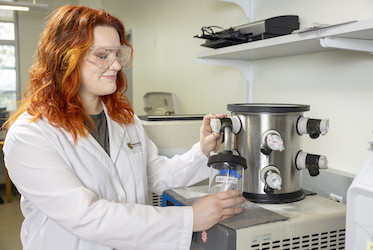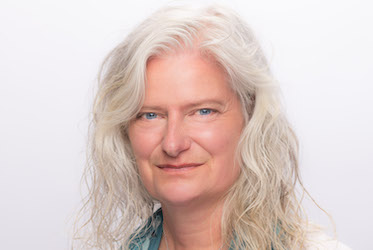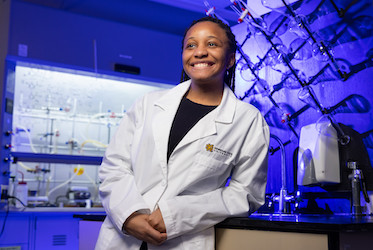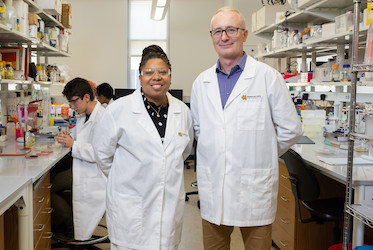
Passing the torch
KENNESAW, Ga. | May 2, 2019
Physics major takes on the cosmos
“Ever since I was a boy, I have been fascinated with the cosmos – both the universe large and small,” said physics student Mike Reynolds, who graduates from Kennesaw State on May 8 and will be heading to Vanderbilt University’s doctoral program in experimental particle physics.
The president of KSU’s Society of Physics Students, Reynolds credits people like the late astrophysicist Carl Sagan with stoking his interest in the cosmos.
“In my late teens and early twenties, I started reading non-fiction books on physics. I discovered Carl Sagan’s Cosmos and then The Demon-Haunted World: Science as a Candle in the Dark,” said the studious but affable 39-year-old Baltimore native who grew up in Pittsburgh. “Sagan often described the universe as being a part of us. He said that ‘The cosmos is within us. We are made of star stuff. We are a way for the universe to know itself.’ That quote is representative of his influence on me.”

After graduating from high school, Reynolds enrolled in the multimedia technologies program at the Pittsburgh Technical Institute. In his spare time, he played the drums and founded his rock band, Faethm. By 2003, Reynolds and his bandmates had moved to Orlando, where they continued to perform. He also worked at Guitar Center and attended Valencia College, where he received an associate degree in general engineering.
“In 2011, I got a job at Valencia’s tutoring center, and that’s where I discovered my passion for teaching and physics.”
Two years later, Reynolds’ band had dissolved, and he felt it was time to put Florida in his rearview mirror.
“I was tired of the perpetual summers and decided to relocate to Atlanta, where my sister lives, to regroup and finish school,” he said. “I worked in restaurants for a couple years to make ends meet before transferring to Kennesaw State in Fall 2016 for a bachelor’s degree in physics.”
Reynolds joined the Society of Physics Students on the Marietta Campus and helped reinvigorate the club. He also began teaching Physics II labs at KSU in Spring 2017 and tutored students in Physics I every semester as a teaching assistant.
“As club president, I worked hard to make it an active organization, and we started construction of muon particle detectors as a club project. It eventually evolved into my focused research area,” he said.
Muons are particles created by collisions between the Earth’s upper atmosphere and cosmic rays, the high-energy atomic fragments from deep space traveling near the speed of light.
Under the direction of David Joffe, an associate professor of physics, Reynolds and several club members built multi-wire proportional chambers, which are used in muography, an imaging technique that uses muons to allow researchers to see through targeted objects. They measure the muon flux with particle detectors through large geographical or archeological structures, such as pyramids or cave systems, to help determine their composition.
Reynolds’ fascination with muography landed him a top spot as one of Kennesaw State’s Birla Carbon Scholars, as well as a presenter in the National Conference on Undergraduate Research held at KSU this year. He also presented for the second year in a row at the American Physical Society meeting held last month in Denver. Both years he won one of the few Top Presenter awards given to undergraduate presenters at the APS conferences.
As he prepares to graduate, he passes the torch of the muon research project to a dedicated group of physics students who are just as intrigued with the possibility of doing muography on one of the Mississippian mounds that stretch from the Mississippi River Valley to the shores of the Great Lakes and include the Etowah Mounds in Cartersville.
Reynolds hypothesizes muons passing through the huge, prehistoric man-made earthen structures will shed some light on the mystery of what lies beneath them.
“Now, I am entering the next chapter of my life,” Reynolds said of his research at Vanderbilt, which will involve working on a nuclear particle physics experiment called sPHENIX at the Brookhaven National Lab’s Relativistic Heavy Ion Collider.
“This will be probing the quark-gluon plasma, an exotic state of matter formed when heavy atoms like gold or lead are smashed together near the speed of light. It will tell us about the conditions in the first millionth of a second after the Big Bang when the entire universe was a quark-gluon plasma.
“This is pretty much a dream come true,” he said.
Carl Sagan would be so proud.
– Robert S. Godlewski
Photos by David Caselli
Related Stories
A leader in innovative teaching and learning, Kennesaw State University offers undergraduate, graduate and doctoral degrees to its more than 45,000 students. Kennesaw State is a member of the University System of Georgia with 11 academic colleges. The university’s vibrant campus culture, diverse population, strong global ties and entrepreneurial spirit draw students from throughout the country and the world. Kennesaw State is a Carnegie-designated doctoral research institution (R2), placing it among an elite group of only 7 percent of U.S. colleges and universities with an R1 or R2 status. For more information, visit kennesaw.edu.



















